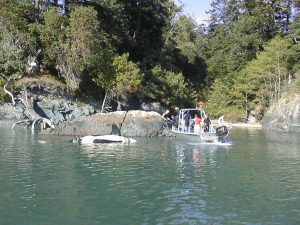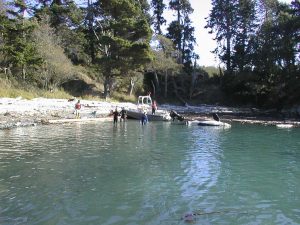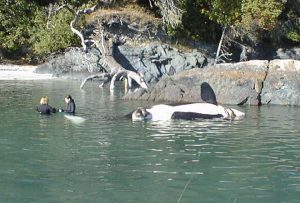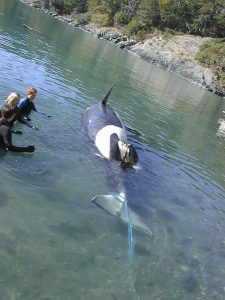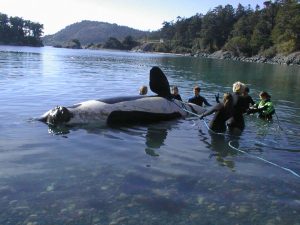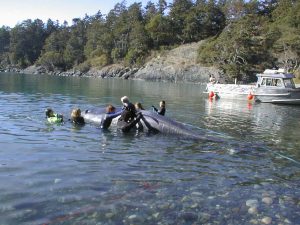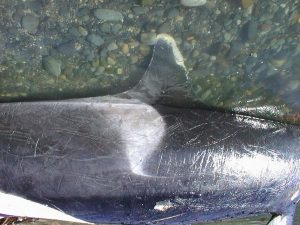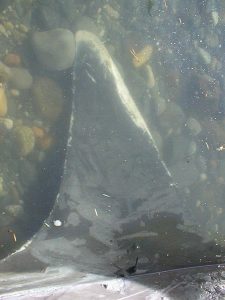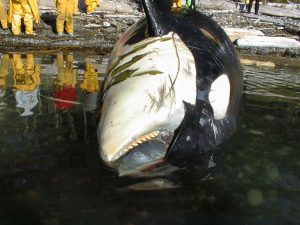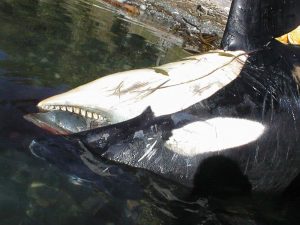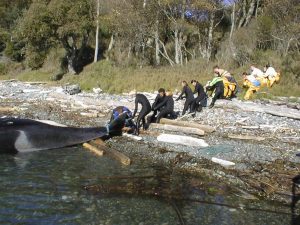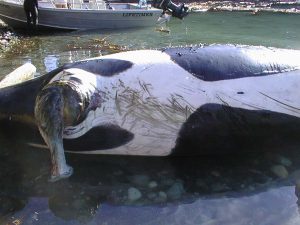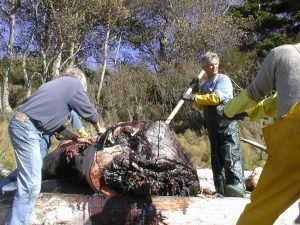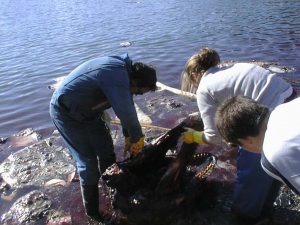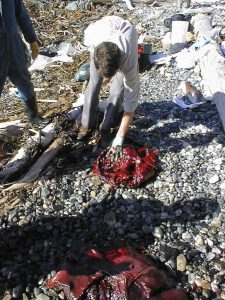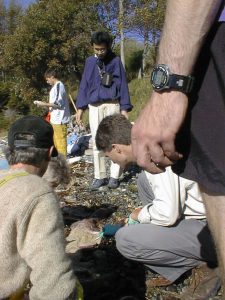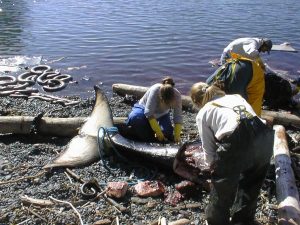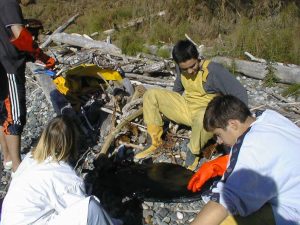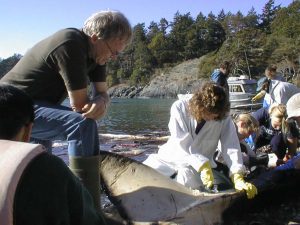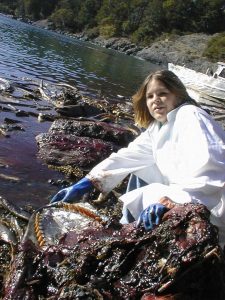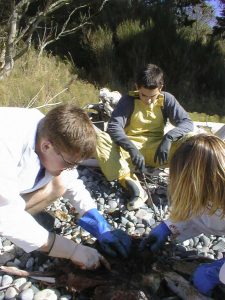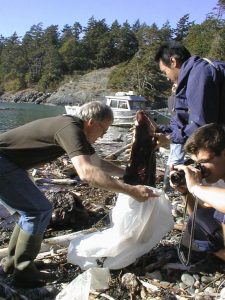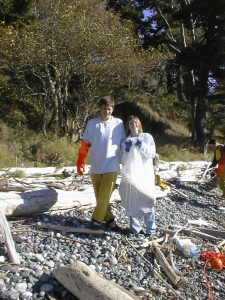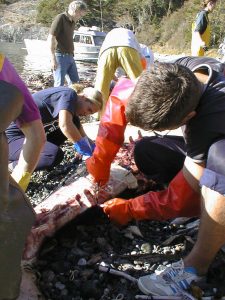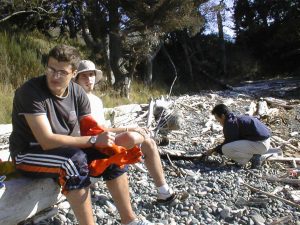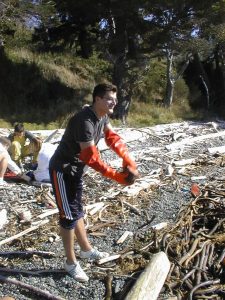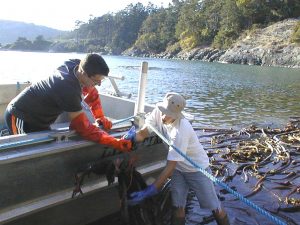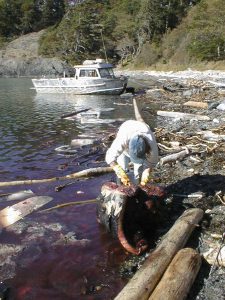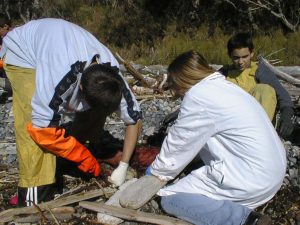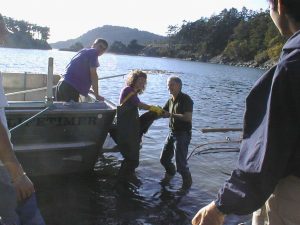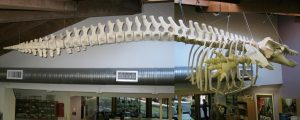Orca L51 Removed From the Strait of Juan de Fuca
On the weekend of September 25, 1999 a dead female Orca was reported by a Canadian Coast Guard employee, Wayne Ingalls.
It was floating in the area of Christopher Point near Bentinck island at the eastern end of the Strait of Juan de Fuca, just adjacent to Race Rocks. On Tuesday, the 28th we were informed at Pearson College and a team of students from the diving service went out to secure the body in a small bay near the Point.
- The Department of National Defense staff at Rocky Point gave us permission to haul out the whale on the beach in Whirl Bay.
- Divers: Hannah-from Great Britain, Jane from BC, Shamsher from BC, Santiago from Argentina,
- Mikkel from Denmark, Stephanie from Manitoba help manoeuvre the carcass.
- These pictures taken initially by Ingi were sent to Graeme Ellis of the Pacific Biological Station in Nanaimo, to assist in identification of the whale.
- Attempts were made to roll the carcass in order to get a better view of the dorsal fin to aid in identification.
- The Orcas from the Vancouver Island and lower Gulf islands are identifiable by the shape of the dorsal fin and the gray saddle patch behind the dorsal fin.
- The dorsal fin under water.
- Ventral side view
- The students pulled the whale up on the beach as far as possible so as to have it out of the water the next day at low tide.
- Further advancement onto the beach was provided by a winch from the Fire Department at Rocky Point
- Possible evidence of a prolapsed uterus.
- On Wednesday, responding to a request from Graeme Ellis, two members of the Biology staff of Lester Pearson College, Catrin Brown and Garry Fletcher and twelve volunteer students went out to assist in the dismantling of the skeleton
- Graeme and Ken had already made identification. The female Orca was believed to be from the L pod — #51. Born in 1973, she has had several offspring and had given birth earlier in the year.
- Her calf had been spotted as late as a week ago swimming with other members of the L pod who are trying to feed it fish. It was reported to be in weakened condition, and it eventually died of starvation.
- Graeme was assisted by Ken Balcomb and his team from the Center for Whale Research in Friday Harbor (in the US San Juan Islands),
- Diane Claridge, Dave Ellifrit and Candace Emmons.
- Also helping with the necropsy were Brian Gisborne of Juan de Fuca Express, Ron Bates from MMRG, Rick Cohen,
- Satoshi looks on as veterinarian, Peter Ross from IOS, Jennifer Poole from Malaspina University-College, and Lara Gibson, biologist
- After an hour and a half of work with his assistants, considerable headway had been made in removing the skull and the blubber from the upper half of the animal.
- Blood and tissue samples were taken by Peter Ross, a toxicologist from the Institute of Ocean Sciences in Pat Bay.
- Alesandro works with Candace Emmons
- Katy, Joao and Mada
- Biology teachers Garry Fletcher and Catrin Brown
- Garry unties the line around the tail fluke which was used to haul the whale ashore
- Garry and Katy
- Katy from Hong Kong
- Jim from Alberta
- Garry and Chin Hin from Hong Kong
- Joao from Portugal
- Mada and Katy
- Satoshi from Japan
- Florian and Alesandro from Italy..Post-necropsy exhaustion. Work went on until 6:00PM that evening. In that time, the whole skeleton had been separated, and most of the tissue cleared from the bones. taking a rest
- Florian from Albania
- florian and Alesandro loading bones onto Second Nature. The bones hung suspended several months in the ocean until the marine animals cleaned them.
- Thanks to PC student Ingi Finnsson for braving the aroma to take the pictures of the necropsy.
- Gaia from Italy
- Garry and Catrin hoist a piece of the skeleton into the boat while Jim prepares to catch..
- Garry dragging the ribs to suspend from the docks so that they can be cleaned by shrimp.


